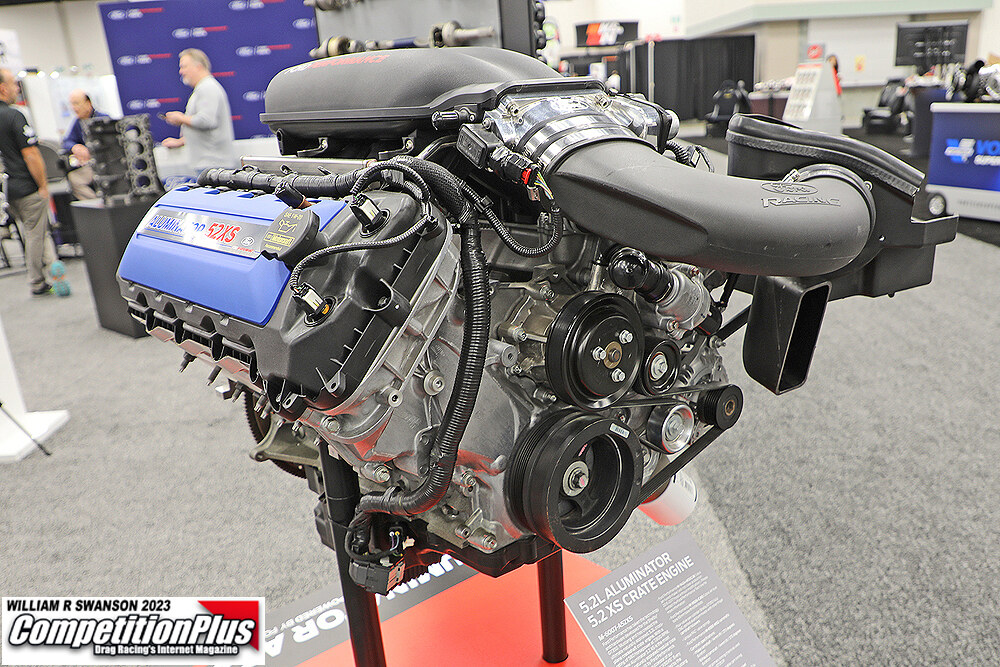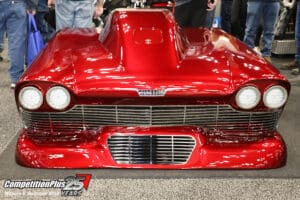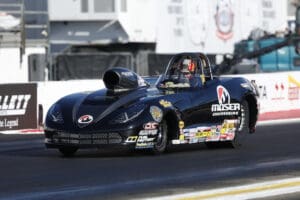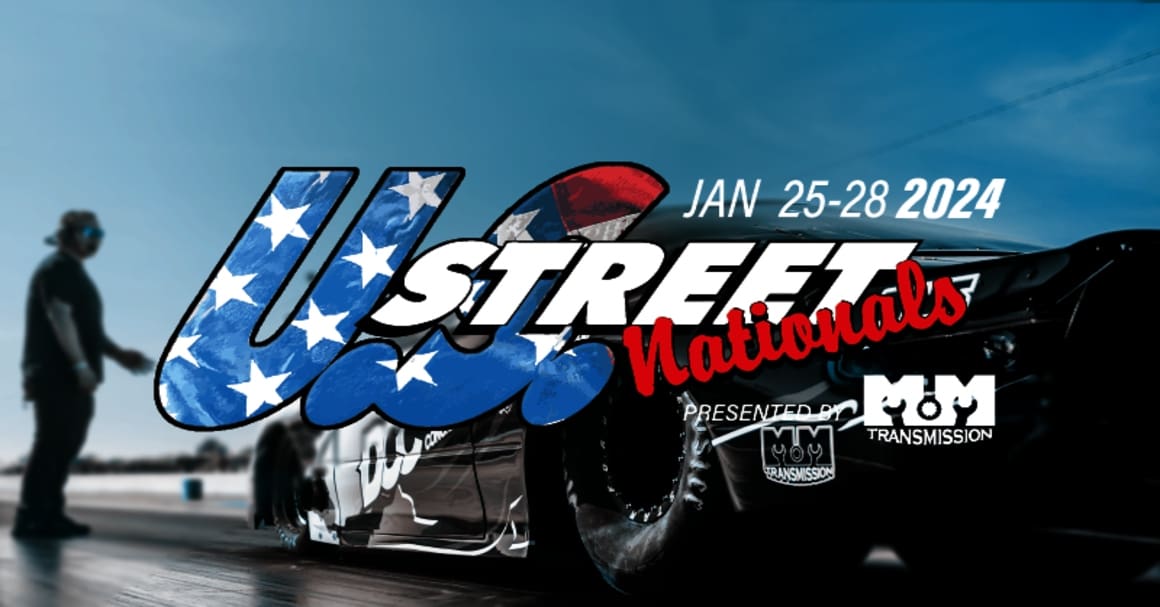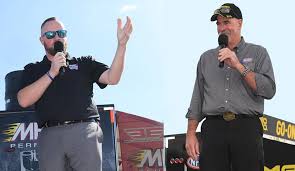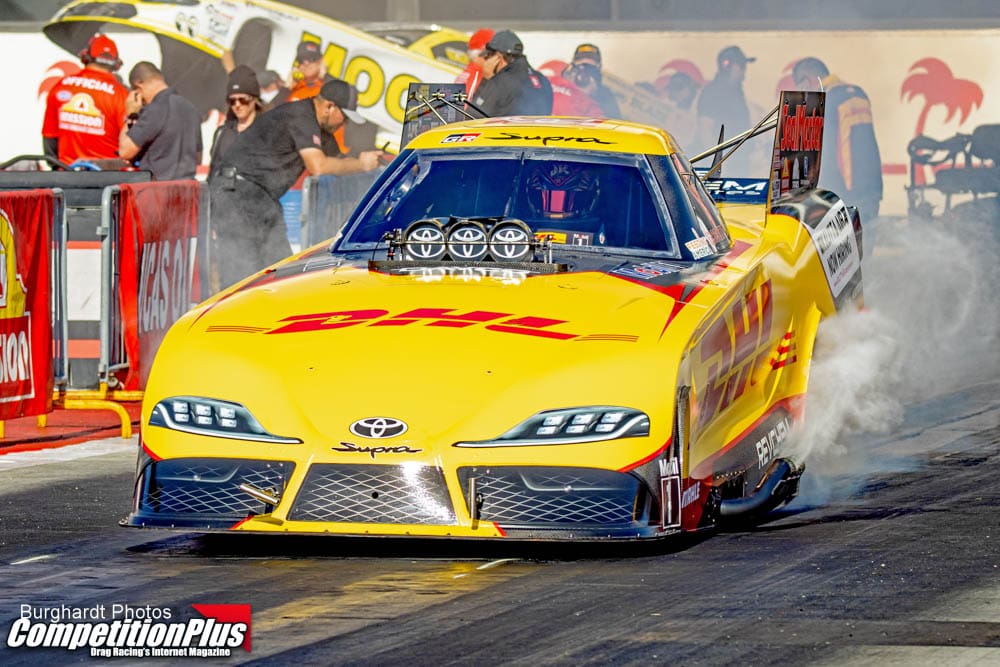 Jimmy Prock didn’t invent the laid-back exhaust headers that have caused the latest buzz in the NHRA Funny Car pits.
Jimmy Prock didn’t invent the laid-back exhaust headers that have caused the latest buzz in the NHRA Funny Car pits.
However, he’s getting credit for his use of them and how they have enhanced title contender Jack Beckman’s 2015 performance. Moreover, Prock is receiving recognition for triggering their increased use as Don Schumacher Racing’s rivals (and even other DSR competitors) try to neutralize Beckman’s record-setting, race-dominating capability.
Ron Capps pointed out and Tim Wilkerson – along with crew chief Donnie Bender and car chief Chris Kullberg of the Snap-on Tools Toyota team – confirmed that Cruz Pedregon has been using the all-of-a-sudden must-have headers for nearly three years.
“That just came from the alcohol days,” Wilkerson said. “I don’t know where Cruz got the idea, to tell you the truth. He had them before anybody [in the Funny Car class].”
The late Dale Armstrong, among others, experimented and tested with them years ago, as well.
Bender said Pedregon worked “about three years ago” with the builder to fashion the design of the early laid-back headers for a Funny Car. “He just didn’t like the design everybody had, and so he did it and it helped him out,” Bender said. His innovation didn’t rate a lot of public attention, Bender said, because “Cruz isn’t here for the glory. He just wants a good-running car.”
Pedregon found an edge. Prock, with his own version, turned it into a nightstick, clubbing his / Beckman’s opponents until these other crew chiefs caught onto why the Infinite Hero Dodge was lowering elapsed times with alarming fury.
Then when the new header package actually became a game-changer after the midsummer Sonoma race, it didn’t get any fanfare right away, because it offered a genuine performance edge.
Other teams began copying the slight degree change with the headers. But they discovered more than just a performance pick-up. With the E.T. gains also came some “side effects” that made the Funny Cars ill-handling. Suddenly, careful, reliable drivers – including Capps, Del Worsham, Matt Hagan, Robert Hight, Tommy Johnson, Chad Head, and others, even Beckman – saw their cars lurch toward the wall or center line. So these 10,000-horsepower beasts got even more belligerent.
Still, no one spoke about them. Finally, immediately after he won the Dallas event, Worsham said, “Can we talk about why the cars are making the moves they’re making right now? I haven’t said anything about it. It’s like the big elephant in the room.
“These headers we’re running today . . . you know, that [Don Schumacher Racing crew chief] Jimmy Prock came out with, that increased our performance to a certain degree . . . They’re very directional,” he said after both he and Beckman had near disqualifications in that final round. “So if our car drops a cylinder, it really steers you hard – harder than I’ve driven in my 25 years. You see Jack out of the groove and you see my car making these huge moves. These new headers which increase performance, when there’s a problem, they also compound that problem.”
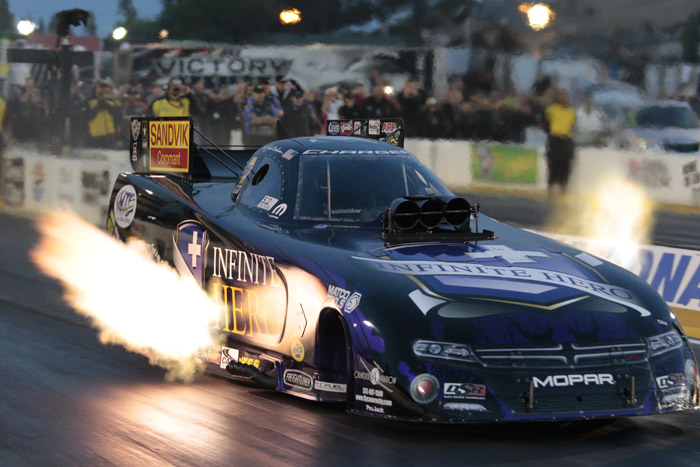 Worsham detailed how his team learned about Prock’s header tweak and the evolution of it on his DHL Toyota Camry that has him in the points lead, 38 ahead of Beckman, as the showdown at Pomona is set for next weekend.
Worsham detailed how his team learned about Prock’s header tweak and the evolution of it on his DHL Toyota Camry that has him in the points lead, 38 ahead of Beckman, as the showdown at Pomona is set for next weekend.
“We kind of had a game plan. I felt pretty comfortable with it. Felt things were going pretty well up through Seattle. We got to Denver, we didn’t do real well there. We went to Sonoma, watched Jack win that race. We did OK there. I thought maybe the sea level, Jack and them are coming off of Denver, they have a little momentum. So we’d be K. We go to Seattle, he outruns us by a pretty good amount. By the time we got to the semifinals in Seattle, we were running close to where he was. I felt like things are OK here. Got to the final round and dropped the ball, lost that final round, which we definitely should have won, to Tommy Johnson. Left Seattle, felt like we closed the gap. Whatever happened with Jack, we were right there in the field and we were going to be OK,” Worsham said.
“Then came Brainerd. We rolled in there and found out our car was not competitive with Jack or Tim Wilkerson or any of the Schumacher cars or Force cars,” he said Thursday during an NHRA-generated teleconference.
“After Brainerd, a first-round loss, we had a meeting,” Worsham said. “We had a test day set up for Indy on Thursday. We were going to get everything dialed in for Indy, get ready for the Countdown. Leaving Brainerd, I went to our team manager, Jim Oberhofer. I said, ‘We better get straight over to Indy and start testing, because we don’t have a fast enough car here.’ I jumped in the hauler, drove with the guys. I was scheduled to go home. We started Wednesday morning and put together a pretty good little combination there and felt like we definitely closed the gap to a certain degree. Again, Jack still had a little bit of a performance advantage on us. Ran Indy. We had a couple decent runs. Went out in the semifinals, not by performance, probably more by luck, getting down the track.”
Before the U.S. Nationals, Capps said, “Lots of really, really, experienced and good crew chiefs would walk through the starting lanes and didn’t notice” Prock’s redesign of the headers. But by the end of the Labor Day classic, they all were catching on.
Worsham said his Nicky Boninfante- / Jim Oberhofer-led team “took another hard look at the situation, our car, where we were, knew that some more changes had to be made. We’ve been missing one thing on the car. We knew a couple things they were doing over there. They made this huge exhaust header change on their car and we hadn’t done it. Didn’t think too much about it. Back in the past, ’95 through 2005, we kind of made those changes on and off, didn’t really see a big change in it.
“After reviewing some video of our car and Jack’s car, his car was definitely leaving the starting line different than ours,” he said. So they mobilized.
“I believe Monday night of Indy, we got together at JR Todd’s house, called the header manufacturer, said, ‘Hey, we’re missing something here. Our car is fast, but Jack has five-hundredths on us. We need to do something.’ He built us some headers,” Worsham said. “I’m not sure if he built Jack’s headers. But they were more of Jack’s design. We put them on in Charlotte, and it definitely was the missing key. [We got] instant results from that point forward.”
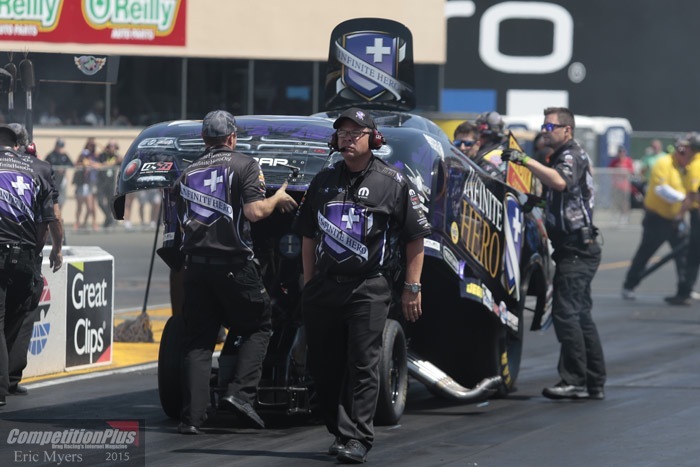 Bender said, “The difference between them is 45 [degrees]. That’s what they’re back at now. They were 38 before. So it’s seven degrees, so it’s a little different. It definitely helps. With the ride height sensors, it doesn’t push down as much as soon as you step on it, so it’s a little easier to get the car down the track. You get a little extra E.T., and if your combination’s easy enough, then it would help you.”
Bender said, “The difference between them is 45 [degrees]. That’s what they’re back at now. They were 38 before. So it’s seven degrees, so it’s a little different. It definitely helps. With the ride height sensors, it doesn’t push down as much as soon as you step on it, so it’s a little easier to get the car down the track. You get a little extra E.T., and if your combination’s easy enough, then it would help you.”
Wilkerson had some on his Levi, Ray & Shoup Ford Mustang last year and ran them for two or three passes. He removed them because he had other problems with his car, but this year he started with a more common cylinder head, so he tried the laid-back ones again.
“And it works,” he said at Las Vegas. “It does seem to make a bit of a difference.
“I don’t know that they’re the messiah that everybody makes ’em out to be, but there probably is a little performance advantage in it. And some teams have seen bigger advantage than others. Those Schumacher cars really have seemed to pick up on it,” Wilkerson said. “I seriously think the track prep and the conditions we’ve been running under –the conditions are so good – that I think that’s what you’re seeing more than anything.”
Chris Kullberg is Pedregon’s car chief, and he said at Las Vegas that he was surprised at how it gave Beckman such a boost.
“When I heard that other teams said it was because of the headers, I kind of thought it was a joke, because we’ve been doing it for so long,” he said. “We never saw it do anything drastic, and we’ve always had them laying back like that [for three years now].” Of Prock he said, “I think he did it going into the Western Swing. He mastered it immediately.”
“Yeah,” Bender said, “He knew what to do once he got ’em on. Jimmy’s smart.
“Some of the guys who run ‘em say they got about three-hundredths [of a second elapsed time] out of ‘em. That’s the number I hear from different people. In our world, that’s big. We’re not like Pro Stock, who get a hundredth – three-hundredths. That’s big for us.”
Capps’ take was that “that’s not THE reason that he [Beckman] started running all those numbers and track records and national records. But it certainly has helped.”
“It’s a reduction in downforce and induction in force, in propulsion, Wilkerson said. He really wasn’t sure how to assess the new-style header objectively, because “my car’s a roller skate, anyway. It really is. It’s an old Murf [McKinney-built] three-rail.” He called the change “very slight” and but said, “You’d never know by looking at it. It’s probably 15 degrees. It’s quite a bit.”
Capps guessed fewer degrees but said whatever it is, the use of them is a double-edged sword: “This little amount of layback – and it’s not much – has certainly helped the performance. And it’s really made it a different car to drive.”
Bender said, “The problem is you get ’em laying back too far and the front of the car gets light. But now with the bodies they have, with the downforce they make on the front, you can run the headers better backwards. Cruz was the first, and I think the bodies that he ran at that time were able to handle them better.”
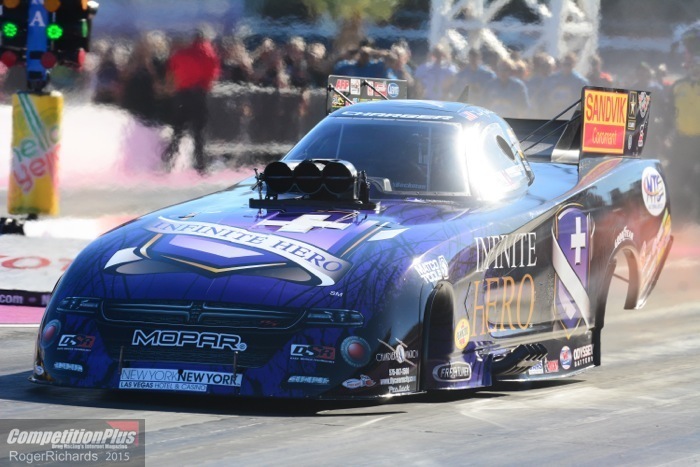 Chuck Beal was preparing to put grandson Brandon Welch in his old Chevy Monte Carlo for his NHRA debut at Las Vegas, and he consulted with Del and dad Chuck Worsham regarding the new technology. What the Worshams told him was that the swept-back headers they had tried in years past never made much difference but with the volume of fuel these modern Funny Cars run and the horsepower they produce make pointing the headers back a little bit actually makes a big difference.
Chuck Beal was preparing to put grandson Brandon Welch in his old Chevy Monte Carlo for his NHRA debut at Las Vegas, and he consulted with Del and dad Chuck Worsham regarding the new technology. What the Worshams told him was that the swept-back headers they had tried in years past never made much difference but with the volume of fuel these modern Funny Cars run and the horsepower they produce make pointing the headers back a little bit actually makes a big difference.
“He said it literally pushes you off the starting line,” Beal said. “The car doesn’t squat as much. It gets up and goes when you hit the gas. Well, that’s all good, but the problem is when you get down toward the finish line, when everything’s kind of dancing around, especially the front end, he says if it gets the least little bit out of shape or drops a cylinder and you’re on the gas, it’ll go whichever way it’s pointed. That’s why these guys are crossing the center line and getting out of shape towards the end. He says it’s really dicey.”
Even before Welch made his first pass in competition yet, he pointed to Capps’ troubles and said, “And he’s as good a driver as there is in a Funny Car. That just shows you what a handful they are to drive.”
Capps agreed: “It has made the cars definitely harder to drive. It’s affecting everybody’s car. People were having a lot of issues hitting cones, people who hadn’t hit cones in a long time, and people who almost hit the wall, got sideways.
“It has tested every bit of us drivers, to learn how to compensate,” the NAPA Dodge Charger driver said, predicting “there’s going to be some more issues through the end of this year. It’s probably the biggest change in driving Funny Cars that I’ve been involved with since I started driving them in ’97. We’ve had to work through some changes we had to make because of the addition of those, for sure. It just been tough for everybody.”
For example, he said Head was upset with his own driving at Dallas because he crossed the center line, clipped the cones, and was disqualified in the first round. Capps reached out to him with consoling counsel: “I’ve made a lot of runs, and I drove what I thought was worse at St. Louis [than Head at Dallas]. These cars are just different now, and you’ve got to catch ’em sooner. And even if you catch it, throttle-wise, it’s no guarantee that the car’s not going to keep going. It just doesn’t react as quick and you have to wait longer for the front tires to grab to be able to move away from the wall or the center line.”
However, Capps said, “We hadn’t seen this jump in performance, in Funny Car for sure, since Snake [Don Prudhomme], probably, back in the day.”
So what the use of these new laid-back headers has done – and Capps has predicted they’re here to stay because no team wants to give up performance gains – is forced the drivers to adjust their driving styles. That’s both perturbing and positive for drivers, perturbing because it has rocked them from their comfort zones bit positive because once again the driver is relevant, not a component that technology is making obsolete.
“I love that it’s difficult,” Capps said. “I hate what happened to me [losing a time in prime Friday-night qualifying, then crossing the center line in the semifinal at St. Louis and handing a struggling Hagan the round-win]. I hate that in these runs I’ve gotten out of the groove. But I love the fact it’s so hard to drive right now. It’s brought that [driver value] back into the equation. There’s no guarantee the crew chiefs can set cars up to run what they’re going to run, because you don’t know if it’s going to make it to the finish line between the cones.”
Progress always comes with pitfalls, and these laid-back headers might be the reason for increased performance. With only a 38-point gap between No. 1 Worsham and No. 2 Beckman with one final race to determine the Funny Car championship, it will be intriguing to see if these newest versions of laid-back exhaust headers contribute to someone’s coronation or demise.
The act of cutting and pasting articles from this publication to a message board is a clear copyright violation as is pulling photos to post on social media sites. All articles and photography published in CompetitionPlus.com are protected by United States of America and International copyright laws unless mentioned otherwise. The content on this website is intended for the private use of the reader and may not be published or reposted in any form without the prior written consent of CompetitionPlus.com.















